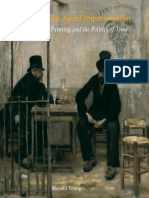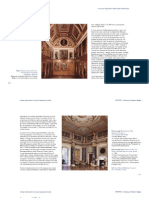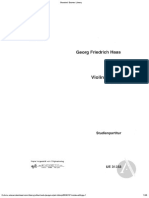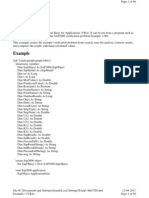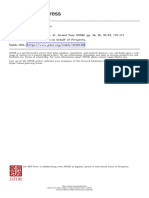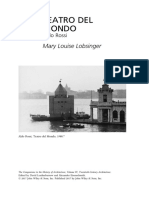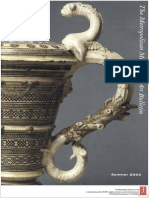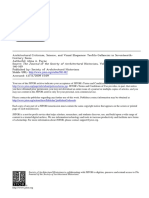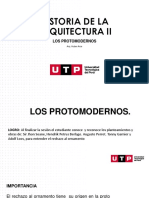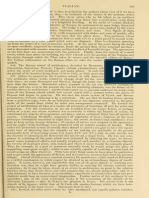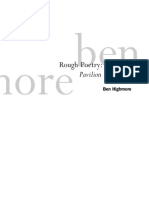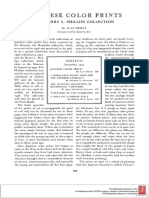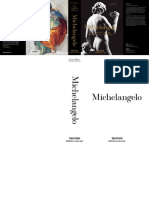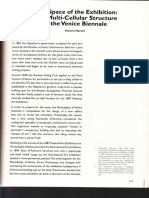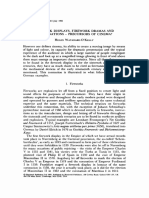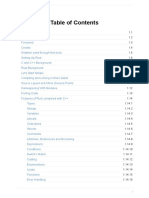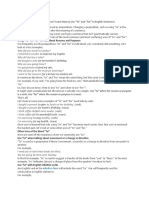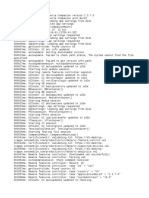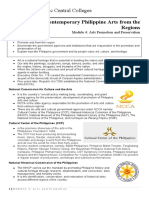This Content Downloaded From 134.21.23.154 On Sun, 27 Sep 2020 09:12:05 UTC
This Content Downloaded From 134.21.23.154 On Sun, 27 Sep 2020 09:12:05 UTC
Uploaded by
Anonymous 9ep4UXzRxxOriginal Description:
Original Title
Copyright
Available Formats
Share this document
Did you find this document useful?
Is this content inappropriate?
Report this DocumentCopyright:
Available Formats
This Content Downloaded From 134.21.23.154 On Sun, 27 Sep 2020 09:12:05 UTC
This Content Downloaded From 134.21.23.154 On Sun, 27 Sep 2020 09:12:05 UTC
Uploaded by
Anonymous 9ep4UXzRxxCopyright:
Available Formats
The Façade of Leone Leoni's House in Milan, the Casa degli Omenoni: The Artist and the
Public
Author(s): Michael P. Mezzatesta
Source: Journal of the Society of Architectural Historians , Oct., 1985, Vol. 44, No. 3
(Oct., 1985), pp. 233-249
Published by: University of California Press on behalf of the Society of Architectural
Historians
Stable URL: https://www.jstor.org/stable/990074
JSTOR is a not-for-profit service that helps scholars, researchers, and students discover, use, and build upon a wide
range of content in a trusted digital archive. We use information technology and tools to increase productivity and
facilitate new forms of scholarship. For more information about JSTOR, please contact support@jstor.org.
Your use of the JSTOR archive indicates your acceptance of the Terms & Conditions of Use, available at
https://about.jstor.org/terms
Society of Architectural Historians and University of California Press are collaborating with
JSTOR to digitize, preserve and extend access to Journal of the Society of Architectural
Historians
This content downloaded from
134.21.23.154 on Sun, 27 Sep 2020 09:12:05 UTC
All use subject to https://about.jstor.org/terms
The Fagade of Leone Leoni's House in
Milan, the Casa degli Omenoni:
The Artist and the Public
MICHAEL P. MEZZATESTA Kimbell Art Museum
Leone Leoni's house in Milan, the Casa degli Omenoni, is one of the
palace facade before they appeared on the Casa degli Om
It earned
city's most distinctive architectural landmarks. It has long is not the
surprising, therefore, that these captives gave
attention and admiration of visitors, particularly for its name to the street they face: the Via degli Omenoni, "st
unusualfaade
thetwo
decorated with six over-life-sized barbarian prisoners and bighalf-
men" in the Milanese dialect.2 Yet in addition
place
length caryatids flanking the central portal. Figures of this it had
kind occupies in architectural history, Leoni's hous
never been seen on a house or palace faCade before they appeared
interesthere.
for the insight it provides into the artist's publ
sonality.
This article analyzes the sculptural and architectural sources This article attempts to analyze that personal
of these
figures as well as the architectural sources of the facade inidentify
general. The
the innovative aspects of the facade, and to pr
Casa degli Omenoni is placed within the context of the more
three comprehensive
major explication of the house's iconolo
so innovative
facade types at mid-century, in order to further clarify its doing, the Casa degli Omenoni will emerge as an ex
qualities. Finally, the iconology is discussed, with Leoni's
of dedication
the Renaissance artist's struggle to gain professional and
of the house to Marcus Aurelius seen in relation to the acceptance,
popularity of a struggle in which his own home was a
two books on the ancient emperor by the court historian weapon.
of CharlesThe
V, Casa degli Omenoni thus helps us to unde
Fray Antonio de Guevara. The prisoner motif is linked toLeoni as an artist and a man. As we will see, his home w
the Persian
a demonstration
Portico, and the famous frieze relief showing lions attacking a satyr is of artistic ingegno and an avowal of a c
honor which reveals the artist's self-perception and so
related to a similar device in Filarete's palace for the pseudonymous
pirations.
architect Onitoan Noliaver. It will be seen that Leoni presented himself
to the public less as an artist than as a gentleman in the In
social camp
May of 566 Giorgio Vasari, returning to Italy from France,
of the Hapsburgs. was Leone Leoni's guest in Milan.3 Vasari's visit, which lasted
15 days, must have been particularly pleasant, for he had the
LEONE LEONI'S house in Milan, the Casa degli Omenoni, is the hospitality of a fellow Aretine and to see
chance to enjoy
one of the city's most distinctive architectural landmarks. Lo-
proof of his friend's success-the new facade and courtyard of
cated just a few steps north of the Duomo, it has Leoni's
long house.
earned Indeed, Vasari was impressed enough to include
the attention and admiration of visitors for its unusual facade
decorated with a frieze relief showing two lions attacking a satyr
and especially for the six over-life-sized barbarian prisoners and
two half-length caryatids flanking the central portal (Figs. i, 2).1
Quint
Imposing figures of this sort never had been seen on et Pompeo or
a house Leoni Sculpteur de Philippe II, Paris, 1887, 186-191, 314-
315; A. Brusconi e Ugo Nebbia, La casa di Leone Leoni detta degli Omenoni
(Soprintendenza ai monumenti di Lombardia), Milano, 1913; Eugene J.
Johnson, "Studies on the Use of Herms in Sixteenth-Century Archi-
tecture," M.A. thesis, New York University, Institute of Fine Arts,
This article was developed from a chapter in my doctoral dissertation, 1963, 35ff.; Ugo Nebbia, La casa degli Omenoni in Milan, Milan, 1963;
"Imperial Themes in the Sculpture of Leone Leoni," Institute of Fine Virginia Bush, Colossal Sculpture of the Cinquecento, New York, 1976,
Arts, New York University, i980, done under the supervision of Pro- 266-267; Maria Serena Tronca, "La collezione d'arte di Leone Leoni,"
fessor Irving Lavin, The Institute for Advanced Study. I would like to Tesi di Laurea, Universita degli Studi di Pisa, 1976-1977; Nikki Leopold,
thank Professor Lavin for his kindness in reviewing the draft of this "The Artist's House in the Sixteenth Century," Ph.D. diss., Johns
essay. Hopkins University, 1979,7-8, 182-226; Michael Mezzatesta, "Imperial
i. For the literature on the Casa Omenoni, see: Vasari-Milanesi, vii, Themes in the Sculpture of Leone Leoni," Ph.D. diss., New York
540-541; G. P. Lomazzo, Trattato dell'arte della pittura scultura ed archi- University, 1980, 172-242, especially 172-173 for full bibliography.
tettura, Roma, 1844, I, 363; 11, 333, 339; 1i, 84; E. Plon, Les Maitres 2. Plon, Leoni, 187-
Italiens au service de la Maison d'Autriche. Leone Leoni Sculpteur de Charles 3. Vasari-Milanesi, vII, 35; Plon, Leoni, i88.
JSAH XLIV:233-249. OCTOBER r985 233
This content downloaded from
134.21.23.154 on Sun, 27 Sep 2020 09:12:05 UTC
All use subject to https://about.jstor.org/terms
234 JSAH, XLIV:3, OCTOBER 1985
i ?ir
4n
S I
/ % + / i
1 ?i
+i I
... .. .. + r . .
m~~~~~~
i '+:
I+I++.+
+ ++ + rr +
+ ?-
- ,: Ir B ..+ , + + + , ? -
+t .
.....I .., , + ,
Fig. i. Leone Leoni, Casa
This content downloaded from
134.21.23.154 on Sun, 27 Sep 2020 09:12:05 UTC
All use subject to https://about.jstor.org/terms
MEZZATESTA: FACADE OF LEONI'S CASA DEGLI OMENONI 235
1~
3~
~
: "-,r? i
?/ ~
il? I
r' ?i~
ii; n"C~,~,Sr ,? (i ~??1
~.? 1, I~
P:_ ,
"-~ rse -I-;?-- ~~
.j:i
~L~!"rr ?
:?I~
h.
d""- ~gl9CLYF" ~ra-,laL~EZ~u' ~?
r,
I r
rlrur?---?
g i
-i t
dff
?????????????????????????????????~ -
?-
Fig. 2. Casa degli Omenoni, two
a description of the Casa degli
Leoni's Omeno
desire to dem
the Vite. The passage is worth quoting
derstandable, but hi
of his own home-th
Leoni, in order to show the greatness of his
which he had from
tury-was, nonethel
nature, and fortune's fav
and of most must
beautiful have been
architecture, inLeon
the
full of so many where
capricious he completed
inventions that th
like it in all of Milan.15
Atyears
the divisions
earlier of
andthf
pilasters, six prisoners, 61/2 braccia each, all
gold scudi.5
tween them, in several niches made in imita
The renovation of the Casa degli Omenoni therefore occurred
terms, windows, and cornices very gracef
normally used. All at a high point
the parts of Leoni's career. It was, however, acorrespo
below moment
that had
above; the friezes are been a long time coming. Leoni had
decorated entered imperialvariou
with
design. From the main
service 24door through
years before, in 1542, a passag
as master of the mint in Milan,6
where, in the center on four columns, is the
but it was not until late 1547 or early 1548 that opportunities
Aurelius formed in gesso from the origi
for major sculptural commissions opened when he was invited
that statue Leoni wanted to signal that his
to visit Emperor Charles V at the imperial court in Brussels in
Aurelius. As to the prisoners, that fancy has
people in different ways. Beside that horse
has in his beautiful and very commodious ho
praiseworthy works of marble or bronze, m
procure.4 di Marco Aurelio, formato di gesso da quel proprio che e in Cam-
pidoglio. Dalla quale statua ha voluto che quella sua casa sia dedicata
a Marco Aurelio; e, quanto ai prigioni, quel suo capriccio da diversi
t diversamente interpretato. Oltre al qual cavallo, come in altro luogo
4. Vasari-Milanesi, vII, 540-54I, author's translation. The Italian text s'e detto, ha in quella sua bella e comodissima abitazione formate di
reads: gesso quant'opere lodate di scultura o di getto ha potuto avere, o
moderne o antiche.
Il quale Lione, per mostrare la grandezza del suo animo, il bello
ingegno che ha avuto dalla natura, ed il favore della fortuna, ha con 5. Since the publication of Plon's monograph it has been assumed
molta spesa condotto di bellissima architettura un casotto nella con- that Leoni never went to Spain. Plon showed convincingly that, contrary
trada de' Moroni, pieno in modo di capricciose invenzioni, che non to the assertion of Caen Bermudez, Leoni did not accompany Charles
n'& forse un altro simile in tutto Milano. Nel partimento della facciata V to Spain in i556; Plon, Leoni, 128ff. Moreover, Leoni did not heed
sono sopra a pilastri sei prigioni di braccia sei l'uno, tutti di pietra Philip's directive to go to Spain issued on 20 January '559; Plon, Leoni,
viva; e fra essi, in alcune nicchie fatte a imitazione degli antichi, con 14xff. However, Vasari reports: "Nel tornare Lione di Spagna se ne porto
terminetti, finestre, e cornici tutte varie da quel che s'usa, e molto due mila scudi contanti, oltre a molti altri doni e favori che gli furono
graziose; a tutte le parti di sotto corrispondono con bell' ordine a fatti in quella corte"; Vasari-Milanesi, vII, 538. As Vasari was Leoni's
quelle di sopra; le fregiature sono tutte di vari strumenti dell'arte del houseguest in May of 1566, there is every reason to believe his infor-
disegno. Dalla porta principale, mediante un andito, si entra in un mation is correct.
cortile, dove nel mezzo sopra quattro colonne & il cavallo con la statua 6. Plon, Leoni, i8.
This content downloaded from
134.21.23.154 on Sun, 27 Sep 2020 09:12:05 UTC
All use subject to https://about.jstor.org/terms
236 JSAH, XLIV:3, OCTOBER 1985
~ 917 i
i',iL ...
Fig. 3. FaCade of the Casa degli Omenoni, Milan. Engraving from Lattuada'
(photograph courtesy Clubino Daddi).
It is
order to discuss Leoni's proposal for a from this
bronze period that
equestrian the recon
portrait
of the Emperor. Soon after the between mid-1565
artist's arrival andimperial
at the 1566/1567-
court, Charles V and his sister Mary,
As itregent
standsof the Low
today, Coun-
the facade of
tries, entrusted Leoni with a series of important
remains commissions,
essentially the same as it ap
Comparisons
his first sculptural projects. He withbeen
appears to have engravings
no less of t
scrizione
successful in winning the Emperor's di Milano
personal of Charles
favor. 1738 and M
installed the sculptor in a palaceMilanese of directly
apartment 1745 do reveal some m
below his
own so that he could watch Leoni
Mostatnoticeable
work, and he
is a delighted
third story abov
addition.
in conversing with him for hours.7 The ground
The depth floor good
of Charles's remains
tion
will was such that on 2 November of Leoni
1549 the lateral niches,
was made which ha
a noble
On the
and was knighted, honors not lightly second story,
bestowed seminude fem
on artists."
central and
The projects he was about to undertake portal
the as wellhe
favor as then
the framin
ustrade
enjoyed prompted Leoni to request have
from the been removed.
Emperor the grantIn add
second in
of a confiscated house in Milan located and sixth
the bays
center of have been m
the city
narrow
just north of the Duomo, a certain "casa balconies with
del prato." the
The consequen
request
ings
must have been approved prior to and pediments.1
Leoni's departure from Brus-
The
sels late in 1549, because by i55o faqade
he had belongs
alreadyto the
set uptype
his initi
studio.9 No further references are known
Caprini in until
Rome-aa document ofgrou
rusticated
July 1565 in which Leoni petitioned the Senate of Milan to fix
the house, which was then in a dangerous state of disrepair.1o
7. Ibid., 44-45. ii. Neither of the engravings is completely accurate. Lattuada, De-
scrizione di Milano,
8. C. Dell'Acqua, "Del luogo di nascita di Leonev, Milan, 1738,Leoni
443, implies that
e the
del prisoners
Mon-are
caryatids, simplifies
umento Mediceo da lui eseguito in Milano," the enframements
Archivio of the blind windows
Storico on the
dell'Arte, 2
(1889), fasc. Ii, 78-81. He was also piano nobile, and does not
granted a show the satyr fallingsee
pension, out of the
C. frieze. He
Casati,
also compresses
Leone Leoni d'Arezzo scultore e Giov. Paolo the fagade unduly.
Lomazzo Marc Antonio
pittore dal Re does not show
milanese, Milan,
1884, 64. the prisoners as caryatids but represents them nude with their arms
9. Casati, Leone Leoni, 27 n. i. For a complete discussion of the cir- folded across their chests so that they no longer appear as barbarians.
cumstances surrounding the grant of the house, see Mezzatesta, "Im- He eliminated the rustication on the ground floor and erred in depicting
perial Themes," 174ff. the satyr in the frieze. He also elongated the proportions of the piano
nobile.
Io. Casati, Leone Leoni, 24-25.
This content downloaded from
134.21.23.154 on Sun, 27 Sep 2020 09:12:05 UTC
All use subject to https://about.jstor.org/terms
MEZZATESTA: FACADE OF LEONI'S CASA DEGLI OMENONI 237
???-r r,,,,u cr-r-4- EM rd?X)
-?-
, ~ c.---. ~ -,- -r ?- ?t
;~Z I_~5CI ~~~CI '?I-?*
,l,.?- ? _s
IFI
. . . . . . . . . . . . . . . .
?. -:..i7p :
. .~(llfy
~Ef=" ?--*rr*V cc
Fig. 4. Fagade of the Casa degli Omenoni, Milan. Engraving from Marc Antonio dal
1745 (photograph courtesy Clubino Daddi).
for an articulated piano nobile. Individual elements, ofis
tailing course,
quite distinctive, with sources ranging fro
differ considerably, most notably, the recessed framements
columns placedon the ancient Porta Borsari in Verona t
in narrow slots cut into the wall, the blind windows withon
merae spindle
Galeazzo Alessi's Villa Cambiaso, Genoa (i
Although
enframements, and the layering of the wall surface, Leoni selected his architectural vocabula
all of which
derive from the ricetto of Michelangelo's Laurentian Library.12
tically, the overall impression imparted by the fac
Leoni's only earlier architectural experience was the design
markable in its unity, order, and decorative restrain
of Giangiacomo de' Medici's tomb in the Duomo of Milan (1560-
i563), 3 but he had obviously studied architecture in some detail.
15. Vasari alludes to an antique source in his description, "e fra essi
Vasari noted that Leoni devised niches, termini, windows, and
[the prisoners], in alcune nicchie fatta a imitazione degli antichi, sono
cornices "tutte varie da quel che s'usa,"14 and, in fact, finestre,
terminetti, his de- e cornici tutta varie da quel che s'usa, e motto
graziose." This type was used earlier on the facade of the Palazzo
Cancelleria in Rome, where Leoni also could have observed the refined
use of rustication on the ground floor and the continuous zone artic-
12. For the Laurentian Library, see James Ackerman, ulating
The Architecture
the bases of the pilasters and windows of the piano nobile, a motif
of Michelangelo, London, 1961, 33-44, Figs. 16, 17, 18a. Leoni
Leoni stopped
used on the facadein and in the courtyard. The articulation of the
Florence in 156o on his way back to Milan from Rome. While
courtyard there
niches seems to derive from the windows of the piano nobile
he certainly saw the Laurentian Library. on the Cancelleria. For Alessi's chimerae, see Galeazzo Alessi e l'archi-
13. For which, see Plon, Leoni, I50ff. tettura del cinquecento (Atti del convegno internazionale di studi, Genova,
14. See n. 4. 16-20o Aprile 1974), Genoa, 1975, 435, Figs. 281, 282.
This content downloaded from
134.21.23.154 on Sun, 27 Sep 2020 09:12:05 UTC
All use subject to https://about.jstor.org/terms
238 JSAH, XLIV:3, OCTOBER 1985
,f '??
rt:
rC1
r'
-r?-~-~, v
D. ?
tri
~?
Ir-: ? ~C-~ --?1 II I I - F;:J
c,?:
: "
c;
?i *`.~- f:kr?' ~i~2?E
r-?
r-1,
~W
r
P r
~1 -?:?:
': ::
~24~ ;1;
?r,
P?
:? "p~ i
r:
a~
i Q t
;? f:i
?: r~a
:?r ~ i; I
':i ? ~ jeii% :~;: ?:-k bi--:t-.l-~':" r
.6:
:1?-4
.I,? . I Jlt ,
'f ~:~ %~be; t"~i ~~~ ~"~'
)? ~:X
i; a~
r"
tl:!?r " e;? t.
'?; E ir
?;? 1". I II , e3 ~-?S?~-I~E-'"::,' ~ h?:l:? ~I"~B
" ?I :~? I- aaay~~;~ g~::: I-
ii
.~ r:~"~o~?;
; j_ "~, ;m
~?~
.. h *-
i *I;
45;c,;4 "t ,, -r;
;i:
?I?~;. ??.. ?IL r;X?
II
:r* -?*
9;
c i i -;s ~
; ,li
if
)"?~d$? :ii
T -:i r~p? ~il~i
i "
~ :I
?B,
:"r r-r~I?=?
a
~1Lb
.EZ
-ir? ---~I r4-?
'?
'","r-~ , ?,?12".: j
Sd;e
*LI,- r-r-
k
r: *-1S~i il~ i~_
?.9 iB ~u ;.?r~i 1~
?
?4 c
jipr? ~??
Fig. 5. Casa degli Omenoni, barbarian prisoner on the faCade (author). Fig. 6. Casa degli O
cannot escape the conclusion that, though much thought went confrontation w
into the architectural design, Leoni approached the task as a sculptures domin
sculptor, for the most obvious features of the Casa degli Ome- These prisoners
noni are the six prisoners decorating the pilasters of the ground fact, they do not
floor (Figs. 5-7, 10-12) and the two supporting figures flanking are positioned bel
the entryway (Figs. 8, 9). The prisoners are identified by an the wall surface.
inscription at the top of each pilaster reading, from the left: bination of Mich
SVEVVS, QVADVS, ADIABENVS, PARTHVS, SARMATA, barian prisoners o
MARCOMANVS. This is correct, a
the
Lomazzo reported in i585 that Antonio Abondio had carved herm shaft a
placed
the figures of the fagade,16 undoubtedly from models supplied neatly atop
by Leoni. They are powerfully expressive sculptures overhang
inspired by it, bein
ancient Roman statues of barbarians and are among Leoni's
they most appear suspe
be
impressive achievements.17 Each prisoner is varied in read
the treat- as "applie
the
ment of dress, physiognomic type, and placement of the hands, Doric pilaster
base
and each possesses a bulk which separately presents a potent molding (e.g
i6. Lomazzo, Trattato (i973), 361; a
La Nobilita di Milano, Milan, 1595, 4
Milano, Milan, 1674,
i8. 276.
Pope-Hennessy,
17. They were London,
also 1970,
strongly 86.
influen
Bandinelli; see 19. Ibid.
Mezzatesta, "Imperia
This content downloaded from
134.21.23.154 on Sun, 27 Sep 2020 09:12:05 UTC
All use subject to https://about.jstor.org/terms
MEZZATESTA: FACADE OF LEONI'S CASA DEGLI OMENONI 239
r~:~ --I-~P?)*77;r*~MIC~ ~?r~?*
icI
4 ??? TEC
~p"'
n?:i?~~:.fEd~li ` : t."
i 1,2
~
":? I- . i i"
d
i
:.
t i
:o S I
?i: 2;1 B -
L,
z~c
:1?u~.
yi: -
rnri
;: :'
ii*
r "''Y
\ it
a ~D: h:
:*!:Y
sii i
~ 1..
i._ ~
i::
i~
?Ic-,~~
"i c"r pPPf~::
,? ;
;$
wt
.. I?s
i:;
i ;i
Z I ~
1?a
"~'~""~e3a" ~lsBSb~D^~IF~'T;::` i--..
?;I tt-
i:; ;; In
?? I, ?- sti ?
f i: . lir
A
.,-~
-r " L-:?fl?,r
~ " Ili~ )
?.
j :-~???'
, ? ,z
:i *
~i~ ??iii ? :I;';"U* ~iQ~i( I,
Fig. 7. Casa degli Fig. 8. Casa degli Omenoni,
Omenoni, half-length figurepr
barbarian flank
portal (author).
The use of Milan,
herms on and their debut mustfagades
palace have been particula
century they and been
had effective in calling attention to the palace's
employed on
Marino (i555) andchitect.2z
inThis example may
1562 by well have
Vinceinfluenced
dei Giureconsulti ever,
in his Milan.20 Their
response was very different. a
Both Alessi
Palazzo Marino herms are only "herm heads"; they
represented the are smaller
fir in
architectonically, and have a subordinate posit
overall decorative program. Leoni created a dram
20. Johnson, "Herms," 30ff. See this study on the use of herms in
monumental, three-quarter-length, nontectonic b
the i6th century. The first tectonic use of herms in a Renaissance villa
that were
was by Giulio Romano in the courtyard of the Grotta the
of the focus of the facade.
Palazzo
del TU (c. 1530) and later at the Villa Giulia whereThe
they articulate thenude male figures that flank
half-length,
area around the loggia and nympheum. Even as late as the 1570s the
are also novel (see Figs. 8, 9). They may also r
use of herms was limited to only a few villas in and around Rome. In
to Michelangelo's
Lombardy, however, they proliferated largely through the influence of herms on the Julius Tomb,
Alessi and Tibaldi; see Johnson, "Herms," 28-34. larged, undressed, and moved them out from t
Leoni undoubtedly knew the colossal Pan caryatids that decorated
they sit on a small platform supported by a c
the garden facade of the loggia of the Casino of Pius IV, for work was
with
far advanced by 1560; see Graham Smith, The Casino a lion's
ofPius head, an emblem of the artist. In
IV, Prince-
ton, 1977, ioff.
The Palazzo di Giustizia in Mantua is decorated with 12 giant triton-
head herms on the upper story. This palace, long 21. Johnson,
attributed to "Herms,"
Giulio 32.
22. Aurora
Romano, is now dated to the x7th century and is given Scotti
to Anton in "Per un profilo dell'architettur
Maria
1565),"
Viani. For the current bibliography, see G. Fusconi, Omaggio a Tiziano,
"Il repertorio de- Milan, 1977, 104, suggeste
corativo nelle architettura milanese dell'Alessi," Marino
Galeazzomay have
Alessi been encouraged by Leoni to decora
e l'ar-
chitettura del cinquecento, 488, 491 nn. 8-12. so richly.
This content downloaded from
134.21.23.154 on Sun, 27 Sep 2020 09:12:05 UTC
All use subject to https://about.jstor.org/terms
240 JSAH, XLIV:3, OCTOBER 1985
xp
I
1
~gj:-*
~I
?*
?.- .?:? -,~
i-i
a
~d~
I
rU~_
"~Q~:: a I
:2;
~ne?
?~i9 :?
~ ""i;;
:? ?
~~i"'~-?
i;i'
~-~~??-
-il
.. T~SSVc,
?a
ti
"
t ??M
r. i
Cip
b
:~r??
`? I i
c-
n"
;r
ik~"
?:P_-
i " :2:S
-r ~.?-??-
.i)
'i?w I
I;YHC'~?;?-'
Fig. 9. Casa degli Omenoni, half-length figure
Fig. io. Casa degli flanking
Omenoni, th
barbarian
portal (author).
figures on a platform story,
away fromprovided a prototype
the wall surface,ofLe
si
have been inspired by one of the triumphal
complexity.25 arches h
Antwerp erected for the Although
entry the decoration
of Philip of Le
II (Fig. 13).2 H
of female half-length practice
caryatids of embellishing
were facades
placed on either w
sid
portal at the level of theItaly and the of
springing Casa degli
the Omenoni
arch. Unl
women and Michelangelo's
of herms, who From
that tradition. carry the
the en
late M
on their heads, Leoni's menwas
areemployed to cover
bent forward, facades
wearily su
the balcony's weight on metric
the patterns.
upper back. At the beginnin
The prisoners on the arose
facade ofa the
new Casa
tendency
deglitoward
Omeno f
bound to attract attention,antique artistic
especially and literary
in Milan where sour
the
of patrician houses the
were, decorative
for the most geometric
part, motifs
simpleo
adorned.24 Only Bramante's Casa Fontana (late 149os),
four monumental frescoedinfictive bronze statues
Late Quattrocento on th
Lombardy," Ph
sity, 1980, 4-47.
23. Northern triumphal arches also25.appear
For a to
discussion
have been ofthe
thesource
Casa Fo
zatesta,
for the strange creatures flanking "Imperial
the Nativity Themes,"
relief on thex9xff.
tomb of
26. For the
Giangiacomo de' Medici in the Cathedral of earlier
Milan; types, see: Leoni,
see Plon, A. Mar
150. Rome, 1969, Io4ff.; Gunter und Chri
24. From 1466 private palaces were erected
Dekoration in that incorporated
Sgraffito the
und Fresko 14.
27ff.
latest architectural forms and utilized On the degree
a greater development of theon
of decoration ne
Affreschi
the fagade, though nothing so elaborate Esterni
as a Venezia,
the Casa Milan, 1
degli Omenoni
For a consideration of the earlier Marabottini, Polidoro,
Lombard tradition 104; Gunter
of palace Sc
architec-
ture, see Susan L. Caroselli, "The Casa
rona Marliani
vom and 20.
14. bis zum Palace Building
Jahrhundert
This content downloaded from
134.21.23.154 on Sun, 27 Sep 2020 09:12:05 UTC
All use subject to https://about.jstor.org/terms
MEZZATESTA: FACADE OF LEONI'S CASA DEGLI OMENONI 241
9? i. r
?u;1
r ??
I d.
r.r~a~iP~gC~
tlJ-~
~~2*1
ldr
rm t ;k
j:I :% I 1:
' ~?
1;9"
*i?
I , '?
i ?
I: it j
41 41
~ WC ' ?
9
.1
~; g:;
;:::
"9
4~'
- " "*?i(YZ
s?,-;
i;
i "
,:ii
jr~::: Ir1 r
Fig. ii. Casa Fig.
degli12. Casa degli
Omenon Om
This artistic
development and ethical
was
frescoed stone
facade ofdecorat
contempo
sical authors and
Renaissancepain
societ
type popularized
supplied by by
the P
v
early 520os
sources,
(Fig.
the decor
I4); an
ture in stucco or
aesthetic stone
choice an
in Verona, owner
whichin the
isforef
em
on the Leoni,
keystones of course,
and
Fig. 15). prestige associated
Although differing in their individual characteristics, these onstrated his inten
Paul IV's permissio
facade types are united by their return to ancient art as a source;
by their frequent intention to re-create an ancient edifice in ancient statues, am
terms of ornament and/or structure; and by the classical subject of Marcus Aureliu
matter of the decorations, which invariably refers to the concept riously transport
of ancient Roman virtus with the suggestion that it was an already been conte
attribute of the owner of the house.27 Indeed, it is this latter point is unknown.
aspect of the facades that is perhaps most significant, for the Marcus Aurelius s
27. For a more 28. Celio
complete Malespini,
discussion of
specific palaces, Trattato,
see III,
Mezzatesta, 84."Imp
This content downloaded from
134.21.23.154 on Sun, 27 Sep 2020 09:12:05 UTC
All use subject to https://about.jstor.org/terms
242 JSAH, XLIV:3, OCTOBER 1985
~.L~~t; ,? _"?I-"-- iL~T.-i~?.~-"c:l:? -'4:~~~r~??~j;-~Bri . ?_ .:7:C_
-r" , L
?ipl
r r 11
i .? 1? i
r. '"C;
;d
-i
??::???"-:~~
FI:: x:j
~z t;i~i~k.~i3; ~8~BetiU,?t~i I:
,? i
~-U~_.. ._, _..
IP~YP Y~t~o,
LJt;l~Plr
h` xs~ltcl. 8, -iF"LII??S;~i~&1`,.?
~ I(~F#TP~ ~.. ??S; .?::?
i ct.
OliCoJ=BCtB~,Ef? r*'~~,I u? '?~P -~; ??-*--~?----~-~ ---
~- :*?~
~t~t?I~~
*)
-4'? -
li? f~iCli~ 411~s~ fq
!li ~U~ filiS~ ?Si
-x~ r
r' .?: c:. :-tt::: I~
u
i (: i ?=-?--~-i?v~ ?
it' i i:li i-~;~:tY~
R t i~
" :r
C: a
.7i.r???-j~/:
j. I?i~ .~11 ?A:~ ~I:
ii i i I\ i$\; j:???r)i:~? .:~:'StI
rii ~ i 1 \i
rlrX
?,. ~"?r, r~ 1: f r
".',
i ; t ?,
19-,i
. -`~i
j i; Ii! i iI i i 1t?a~,
ji t-?.:; . :? ~r*u! SY :i
,,.:"_6
,, nf~ iZ~,??L d:l C 3
I, ~,
jr*-?j rl i.
~~ ??e t~: Jr: ; i ? j/jl 1( ?r, r c:Cf`?~-~~
IIII ii ~ ~- .???-?
?? ?-?6 ?L?L.-2 i:
?i
?~
? ~,f- t?-t~r,'L,
?r r !r.
,~v?:r
/ $~-CUI ICJY1 :---4
'?=??1.S-~
S~LI~..~"I..- _____ t__l?_IXI- ~---- -?L ?';'"? --------i~.t`~
.?.-I----~.-~~L._~.~____. ' C- ~~-
?- --.
~ii;i~ ----^.1._-
r--"-~-~
-???--?----~?rrrr-?---. .
?--?-------? ..? ?c----1L. : ?----
~
:1: ~ i
c:
-~lf~i~l~ b;;ii~":?-"~rra ?-
i.
??
1.
~-
"
i r~9as~urt~rr~ i r~ ~
!I ???~ ii t * ?~
?~~t-.' lli s ? ii ';i ~IY ~e~J~EI~P" I~a~B~~o rr ?.?
X?. i~.. '? $ ,, ~-4~5~ ~"* IU~ ? ""-~-: i; i.;
j ';i i , i'?Y111
3; 1??,
1 ya. i
- ---
r?
--r
3
iZ.
: j
I
.i?1 ?'1r~i
L
L, ?.1-?SL~r..
~, ~alhT-; ~d~ P r:
br\*.
-~2L,:
*. :91 i? r
I i
C~~I-ka?83t~ I-~.
e1:3~~~
Os
*
I
r,-
i .
":I~:?~sl~BICIIIICI Il??r ?- * i
Fig. Fig. 14. Polidoro da Caravaggio, drawing
13. Tr of the facade
into Antw
a house on Piazzi dei Caprettari, Rome, I52os (Biblioteca
mirable, tres
Philipes...
terpiece o
Gregorius related in the Narracio de mirabilibus u
the house
statue originally was set on four gilt bronze column
altar of Jupiter on the Capitoline Hill.31
Indeed, th Leoni's al
arrangement undoubtedly won admiration
lighted by for its
for it,
accuracy. Similarly, identification
an by inscription of
portal in
oners on the fagade as tribes conquered by Marcu
4).30association evident
The to those people familiar with t
Emperor in Julius Capitolinus's popular Historia A
exactitud
29. See above p. 235 and n. 4. 31. For this early tradition as well as a consideration of the statue's
placement
30. Vasari noted that it was, "sopra quattro colonne"; seeduring
n. 4. the
CarloMiddle Ages, see Philipp Fehl, "The Placement
Torre in II Ritratto, 276, described the arrangement as follows:
of the "a rim-
Equestrian Statue of Marcus Aurelius in the Middle Ages,"Journal
petto alla Porta nell'Apartamento di dietro veggevasi sopra
of the un Ballatoio
Warburg and Courtauld Institutes, 37 (x974), 362-367, esp. 366 n.
l'Aurelio a Cavallo." 21.
This content downloaded from
134.21.23.154 on Sun, 27 Sep 2020 09:12:05 UTC
All use subject to https://about.jstor.org/terms
MEZZATESTA: FACADE OF LEONI'S CASA DEGLI OMENONI 243
of Marcus Aurelius in the courtyard, and the dedication of the
house were public statements which not only proclaimed Leoni's
present imperial ties but also garnered the prestige associated
with the monuments and glory of ancient Rome.
These facts alone, however, neither fully account for the
dedication nor do they explain all the implications and visual
ramifications of the program. The questions remain why Leoni
chose to dedicate the Casa degli Omenoni to Marcus Aurelius,
IrIs why he selected barbarian prisoners to decorate the facade, and
what is the complete nature of the program.
Marcus Aurelius is perhaps best known as the philosopher-
-4fr
emperor and author of the Meditations, the popular collection
of philosophic apothegms on the Stoic way of life. However,
the appeal of the Meditations may be traced less to the i6th than
i?~iL~WB ~ 6w
to the I7th century. In fact, in the cinquecento, Marcus Aure-
lius's renown was primarily the result of one man, the court
%alt
historiographer of Charles V, Fray Antonio de Guevara (1480?-
E1T-:AA
a -? I545).33
oil SO,~ Guevara wrote and dedicated to Charles V two books: the
no 41 Libro Aureo de Marco Aurelio and the Relox de Principes. The
n!5
former appeared in 1528 and purported to be a translation of
1? -- IA
the Greek manuscript of the Meditations. In fact, it is a more or
less imaginary biography based on Julius Capitolinus's Historia
Augusta. The Libro Aureo reviews the Emperor's entire life with
Fig. 15. Michele special
Sanmicheli, fagad
attention devoted to his outstanding virtues, especially
1530S (Brogi).
his sense of justice and clemency and his continual concern for
the well-being of the state. The book was conceived in the
tradition of the Speculum Principum (Mirror for Princes), edu-
no less cative tractsin
effective designed to calling
produce good rulers, but it also pre-
atten
tion.32 sented a richly drawn portrait of Marcus Aurelius not only as
These captive barbarians appear as trophaic emblems of Mar- an emperor but also as a man with personal problems, a fact
cus Aurelius and his virtus. They exist as proof of the greatness that contributed to the book's popularity.34
of the Emperor and the grandeur of empire, past and present. The Relox de Principes is three times as long as the Libro Aureo
The connections between the Roman Empire and the Holy but actually incorporates almost all of its chapters into a con-
Roman Empire were well known and were a popular equation siderable body of new material. Like the Libro Aureo, the Relox
in the Emperor Charles V's imperial panegyrics. Leoni, as im- is a moral, didactic treatise in the tradition of the Mirror for
perial sculptor knighted by Charles V, naturally occupied a place Princes. The book is a comprehensive presentation of Guevara's
in that equation. The prisoners on the facade, the plaster cast political ideals wherein Marcus Aurelius is held up as an example
for any man who aspires to a virtuous Christian life.35
Both books were enormously popular throughout Europe
32. None of the early sources identifies the barbarians as anything
other than prisoners. Plon records the inscriptions but does not discuss during the i6th century. In Italy alone from 1542 to i6oo, an
them further. Nebbia in La casa degli Omenoni in Milano, 9, 21ff., refers edition of the Libro Aureo or the Relox was published at a rate
to the captives only as tribes once dominated by Rome. Johnson in
"Herms" connects only the Quadi and Samarti with Marcus Aurelius.
Pope-Hennessy appears to have been the first scholar to link all six
prisoners with tribes subdued by the Emperor; see High Renaissance, 86.
In fact, five are mentioned in the most famous ancient biography of 33. The influence of Guevara and his books has been discussed in
Marcus Aurelius, Julius Capitolinus's life of the Emperor in the Historia detail by the author in "Marcus Aurelius, Fray Antonio de Guevara,
Augusta, an edition of which, edited by Erasmus, appeared in 1518: the and the Ideal of the Perfect Prince in the Sixteenth Century," The Art
Suebi, Quadi, Samarti, Marcomani (all Germanic tribes), and the Par- Bulletin, 66 (I985), 620-633.
thians. The Adiabeni were vassals of the Parthian kingdom and as such 34. Augustin Redondo, Antonio de Guevara (i48o?-i545) et l'Espagne
were almost always involved in its wars with Rome. The tribe is men- de son Temps, de la carridre officielle aux oeuvres politico-morales, Geneva,
tioned in Julius Capitolinus's life of Septimus Severus in relation to his 1976, 489. This is the fundamental study of Guevara's life and work.
Parthian wars and Leoni may have made the connection here. 35. Redondo, Guevara, 3o6ff., 532ff.
This content downloaded from
134.21.23.154 on Sun, 27 Sep 2020 09:12:05 UTC
All use subject to https://about.jstor.org/terms
244 JSAH, XLIV:3, OCTOBER 1985
-P E RPS AE CA -'P TIV I. diately recognizable and highly esteemed among the nobility
of Milan.
The dedication to Marcus Aurelius was also reflected by the
barbarian prisoners on the facade, tribes vanquished by the Em-
peror.37 The captives formed the prelude to the equestrian cen-
terpiece and established the public tenor of the program. Bar-
barian prisoners had appeared earlier on the frescoed palace
faqades of Polidoro da Caravaggio. However, they usually stood
alone, or when grouped were placed in pairs before a trophaeum,
as on the facade of the house at Piazza dei Caprettari (see Fig.
. .c ~*\ 14).38 Their use on the Casa degli Omenoni recalled the trium-
phal monuments of ancient Rome, such as the Arch of Con-
stantine, where four prisoners stood in series in the attic zone
of each face. But Leoni seems to have been inspired by a different
[
source, Daniele da Barbaro's 1556 illustrated edition of Vitru-
vius's De architectura.39 The text described the Persian Portico
erected by the Lacedaemonians after their victory over the Per-
sians: "in quel portico posero i simularchi de i prigioni con
l'ornamento Barbaro del vestire, che sostenevano il tetto."40 The
accompanying engraving shows a portion of the portico with
two caryatids of the familiar Roman type (Fig. 16). The typo-
logical relationship to Leoni's prisoners is evident (cf. Fig. i).
Fig. Although he eliminated their supportive role, Leoni also Da
i6. joined
his captives to the building, unlike the prisoners of the Arch of
graving f
(Harry Ra
Constantine who stand before the architecture. In addition,
at Austin).
when barbarian statues were used on triumphal arches they
usually decorated the attic zone. Similarly, when frescoed bar-
equivalent to one almost every i8 months.36 The vast diffusion barians or herms appeared on palace faqades, as at Palazzo Marino
of these works is a measure of the wide appeal of Guevara's
political-moral treatises.
37. See above p. 238.
The Libro Aureo and the Relox de Principes gave a new di-
38. See above p. 241. In the Sala Grande of the Palazzo Doria in
mension to the personality of Marcus Aurelius, popularizing the Genoa two under-life-sized sculpted barbarian caryatids support the
Emperor as the ideal prince. As the best of all the pagan Roman mantel of the fireplace; see Venturi, Storia dell'arte, x, i, Fig. 374.
An antique barbarian statue may have been placed on the facade of
emperors he represented the supreme example of ancient virtus.
Palazzo Valle-Capranica in Rome; see Hiilsen, Das Skizzenbuch des Gio-
His life and writings provided an elevated standard of com- vannantonio Dosio im Staatlichen Kupferstichkabinettzu Berlin, Berlin, 1933,
portment not only for the ruler but also for all men who sought 5, no. 17a, f. 6v. However, this figure was armed and was not a prisoner.
to lead a Christian life. 39. Bush, Colossal Sculpture, 267. However, Bush adduces the 1567
edition. The fagade was well under way or completed by that date.
It seems likely that the Casa degli Omenoni stands as an 40. I dieci libri dell'architettura di M. Vitruvio tradotti et commentati da
example of that new popularity, for in dedicating his house to Monsignor Barbaro, Vinegia, 1556, zi. The entire entry reads:
Marcus Aurelius, Leoni probably referred to the image of Marcus Similmente i Lacedemonij sotto Pausania figliuolo d'Egisipolide dopo
Aurelius popularized by Guevara. In so doing, he associated il fatto d'armi di Platea havendo con poca gente superato il numeroso
essercito de' Persiani, & con gloria trionfato; de i denari tratti delle
himself with this most virtuous of ancient emperors. At the
spoglie, & della preda in luogo di trofeo della vittoria 1 posteri fa-
same time, because both books were dedicated to Charles V and bricarano il portico Persiano dimostratore della lode, & della virti~ de
because of Leoni's position as imperial sculptor, the artist en- Cittadini, & in quel portico posero i simularchri de i prigioni con
l'ornamento Barbaro del vestire, che sostenevano il tetto, havendo
joyed a second flattering association. Leoni's public profession
con meritate contumelie la lor superbia castigato. A fine che i nimici
of a personal code of honor and virtue must have been imme- cagione havessero di temere gli effetti della fortezza loro, & i Cittadini
guardando in quello esempio di virt-i della gloria sollevati alla difesa
della Patria s'eccitassero grandemente, la dove ne i seguenti anni molti
cominciaro a porre le statue Persiane che sostenevano gli archi, & i
36. For a listing of the Italian editions, see P. Lino G. Canedo, "Las loro ornamenti, & indi trassero argomento di accrescere nell'opere
Obras de Fr. Antonio de Guevara," Archivo Ibero-Americano, 6, no. 44 maravigliosa varieta di maniere, di simiglianti Istorie altre ne sono,
(1946), 467-472, 493-497. delle quali bisogna che L'Architetto ne sia ben informato.
This content downloaded from
134.21.23.154 on Sun, 27 Sep 2020 09:12:05 UTC
All use subject to https://about.jstor.org/terms
MEZZATESTA: FA(ADE OF LEONI'S CASA DEGLI OMENONI 245
~ ? ~ ?-? ri 14;?
AS.x'g
N 1??.??:
d' / IAP n;?
. e k
'lot
, lp
ISM o
'hli i
Fig. 17. Anonym
Woods Ltd.).
or Palazzo dei Giureconsulti in Milan, they were restricted to The monumental size and trophaic quality set Leoni's men apart
the upper stories. This reflected a tendency of Italian palace and suggest one source in particular. Jacques DuBroeucq, the
decoration that viewed the second story as the place to receive architect of Mary Queen of Hungary's palace at Binche, intro-
figural decoration. By arranging his series of prisoners on the duced trophies on the window wall of the great hall (c. 1545).4
ground floor and by presenting them on a monumental scale, In an anonymous drawing of the x6th century, trophaeums
Leoni introduced a new pattern of sculptural disposition, one composed of a cuirass, shields, swords, and a helmet with a
which derived directly from the Persian Portico. mask-like face are visible flanking each window (Fig. r7).
But the Persian Portico does not account for the most re- DuBroeucq's trophies differ significantly from earlier Renais-
markable aspect of Leoni's prisoners: their brutal amputationsance examples. They were isolated from the overall decorative
below the knees. This fragmentary quality and the fact that they
seem to be suspended on their shafts recall the classical tro-
41. The palace at Binche was built under DuBroeucq between i545
phaeum, the battlefield trophy wherein the spoils of war-
and 1549. For this project, see Robert Hedicke, Jacques DuBroeucq von
breastplates, weapons, helmets, and shields-were hung on lancesMons. Ein niederlandischer Meister aus der Fruhzeit des italienischen Einflusses,
as an anthropomorphic emblem of the vanquished, a symbol ofStrasbourg, 1904, i6off. For the anonymous drawing, see Albert Van de
Put, "Two Drawings of the Fetes at Binche for Charles V and Philip
victory. This type had been adopted earlier by Renaissance artists
II in 1549,"Journal of the Warburg and Courtauld Institutes, 3 (1939-1940),
in palace decoration, though on a much smaller scale and as49-55. For the palace at Binche, see also Christiane Loriaux,Jacques du
frescoed or stuccoed elements within a larger decorative whole.Broeucq (1505-1584), Gembloux, 197x, 19ff.
This content downloaded from
134.21.23.154 on Sun, 27 Sep 2020 09:12:05 UTC
All use subject to https://about.jstor.org/terms
246 JSAH, XLIV:3, OCTOBER 1985
context in which the preceding types were found and were made intervention of powerful friends spared Leoni, although the new
the dominant feature; they were presented in series; they were sentence might have been considered even worse: an indefinite
colossal; and they were placed on herm shafts rather than on period chained to an oar as a galley slave in the papal fleet. Even
crossbars or stakes. after he was released and had established himself in Milan, Leoni
Leoni, who visited Binche late in 1549, must have been in- remained defensive and belligerent, hiring an assassin in 1545
fluenced by these unusual herms, particularly their dominant to kill an assistant who refused to return with him from Venice.
setting, serial arrangement, huge scale, and fragmentary form. Yet, perhaps even more shocking was the knife attack in 1559
In fact, Leoni combined these elements and their placement on on his house guest, Orazio Vecelli, the son of his close friend
herm shafts with the barbarian prisoner type of Vitruvius's Per- Titian. The violent and sudden assault occurred at dinner and
sian Portico, although eliminating the latter's supportive role. seems to have been motivated by anger over Orazio's contacts
In so doing he created a new type: monumental, living, non- with Leoni's Milanese clients. In his willingness to resort to the
tectonic, barbarian herm-trophaeums. sword, Leoni revealed a temperament jealous of personal gain,
Through the form of the barbarian-trophaeums and their one that was ready to defend honor and privilege against any
relationship to the Persian Portico, Leoni conveyed a message. threat, real or imagined.44
As Vitruvius wrote, the Persian Portico was erected with the Yet in choosing captive barbarians, Leoni signaled that the
spoils of victory and stood as a symbol "of the honor and of the battle was over, the enemy defeated and humbled, with peace
virtue of the citizens"; the barbarians represented "pride casti- and art reigning within his house. In a sense, Leoni's personal
gated" and a warning "that enemies might have reason to fear struggle for security and recognition was over. From poverty
the effects of their [the Greeks'] strength."42 As the Persian and a term as a galley slave, he had been knighted by the Holy
prisoners were a public expression of the "virtu" and the "glo- Roman Emperor, given a home, and been publicly associated
ria" of the Greeks, so the captives on the Casa degli Omenoni with the greatest emperors of ancient and modern times, Marcus
expressed the virtue and glory of Leoni no less than a mute Aurelius and Charles V. The Casa degli Omenoni thus stood
warning to his enemies. The downcast glances and pathetic as a kind of templum virtutis. Leoni had created his own Persian
expressions of the vanquished barbarians signal their absolute Portico in Milan.
defeat, a defeat mandated by the superior "virtu" of their ad- One more feature of the Casa degli Omenoni's facade remains
versary. Similarly, the half-length caryatids flanking the central to be considered: the frieze decorating the second story (Figs.
portal, with their links to triumphal arches, were equally effec- 2, 18). In the center, Leoni had carved two lions attacking a
tive in establishing a triumphant tone (see Figs. 8, 9, 13). satyr who falls backward out of the relief plane, his head dan-
That Leoni chose a military metaphor for the program is itself gling in the pediment of the window below, his left arm des-
highly revealing. One cannot help but sense in the martial and perately clutching the entablature (see Fig. 2). The lions, epon-
admonitory tone of the facade a reflection of Leoni's view of ymous emblems of Leone Leoni, attack the satyr, a beast at once
life as a continuous battle.43 Indeed, throughout his career, Leoni evil and vicious. The concept alludes to the triumph of virtue
was readily prone to violence, his outbursts fueled by a chronic over vice, a familiar theme in Renaissance art and literature.
insecurity engendered by the poverty of his youth. Leoni's life Here virtue's victory takes on a chilling finality as the attack
is marked by numerous conflicts, the earliest of which can be upon the satyr's genitals is not simply a horrible punishment
traced to 1536 when, while working in the mint at Ferrara, he but the ultimate defense against the satyr's procreation of ma-
was accused of counterfeiting and was forced to flee and to seek licious progeny.45 Antonio de Guevara claimed that the greatest
the protection of his influential relative Pietro Aretino. Two thief was one who robbed a man's reputation, for "a reputation
years later, Leoni was in Rome serving at the Papal Court where attacked is forever sullied."46 The relief thus stands as a dreadful
he and Benvenuto Cellini developed into bitter enemies, their warning, a cave leonem, to those who might consider such a
animosity finally exploding in a public shouting match in the felony.
Camera Apostolica. The grudge reached a climax when Leoni Leoni may have had a specific prototype in mind when he
unsuccessfully attempted to poison Cellini while the latter was designed the satyr relief. In Filarete's Treatise on Architecture
imprisoned in the Castel Sant'Angelo. New charges of coun- (x461-1464), the facade of the magnificent palace of the pseu-
terfeiting leveled against Leoni in 1540 by the papal jeweler donymous architect Onitoan Noliaver was decorated with a
Pellegrino di Leuti resulted in Leoni attacking and horribly relief over the main portal showing the allegorical figure of
disfiguring the man with a dagger, an attack for which he was
sentenced to have his right hand cut off. Only the last-minute 44. These episodes are recounted in Plon, Leoni, 4-5, IIff., 30ff., 35-
36, 143ff.
45. Plon, Leoni, i9i.
42. See n. 40 for the Italian text. 46. "Il taglio della fama non si saldera mai in tutta la vita"; Guevara,
43. Plon, Leoni, 191. Libro di Marco Aurelio con l'horologio de' Principi, Vinegia, i562, 2V.
This content downloaded from
134.21.23.154 on Sun, 27 Sep 2020 09:12:05 UTC
All use subject to https://about.jstor.org/terms
MEZZATESTA: FACADE OF LEONI'S CASA DEGLI OMENONI 247
i i i~ ~zJ
II.IINWI~I~~-. -..
r~'~ :`' '~~~"`
~s,~ i
t ,x
~c~?
f~ b
~ a ~: ~?
ir??~r.?-?: ?~.?
:'~~?r~p
.,,r .c?~ls*?:~
i.;
:?r :S:'46~P~~
?cr ,~u)iS ??Iil'
1 5~-?11
:? . ~??? I:: i
~ai j
~"''~bl c~ - -------- '~!~"J~i~i
i:?9r.J~ ~~i~
c
?I
.. Ifil
i iir i r~g~E~Bi~8i
?? ?
/Ik1:
'P:r
~I 1
:;;:~ib~98ll~i$;r~~nIIIIII~Crrtl.,~,~iPs ~~2P;lt i-i. ~ i
:: W ~rjaA~Q ?::
: ~-~ ?%g~?~
WR.
Fig. i8. Casa degli Omenoni, detail of the cornice and frieze (author).
-------u.Lic:l? I ;`:::? ;:::8861~1~ i
: P'?:~P~c;b~lsr-a"lssnr" I I?I~"~~~"~~"'"`;~":"""" ~4L?:::
~ba~ls ~:38i6~ 6
:~B~'l~p~PLR~d~-.~i~~ rsr~a~i~sa~
a?t
Virtue (a winged man standing on a diamond
5 ::and holding a
laurel and date tree) with Vice in the form of a nude satyr
::m
1 ::::i
k
beneath him. A portrait bust of the architect
?:: was also present
iQ
along with an inscription detailing Onitoan Noliaver's achieve-
::Z :i?~?: i::
ments.47 ih :
~.:1:;22
I"i
5: overdoor.48
Leoni may have been inspired by Filarete's " ?: .~x?e:::
Instead:~t :
?::~iC(i!
:??l?ilii~s~?r
of the unwieldy armed warrior, however, Leoni selected:R-?
-?iP~?:i?.-S~ lions, 5sji:s.-,~
??';r~~-1. L
I:li i ~ :: :?:?:?
~?:? ??- :I I~
thereby combining two parts of Filarete's program in one device.
k: I? :b:r:
r?;:n?~o
:: ~?sq 4 ?:?r :~: :'TbE~itdlk~i~: :;::. ~Sj
As the lion is a symbol of virtue, he referred to virtue's
?:
?:?~~?I
:k
:::'
victory
8:~n
:i n
-?-- ~ :o
?`
over vice (satyr), and he replaced the bust
?,; of
I?Onitoan Noliaver
:. rlepLqp~;~:
with a punning self-reference based on his personal emblems.
Fig. 19. Leone Leoni's co
and knighthood (Archivi
47. The idea of virtueBut
was the
central in Filaret
influence o
major iconographical innovation representing t
quotation. It embrace
aissance that Virtus was represented by a singl
of which Filarete wasdantly endowed
particularly with
proud; see
chitecture. Being the tion
Treatise of Antonio
by such palatial
di Piero
trans. with an introduction and notes by Joh
exalted status of the a
Haven and London, 1965, I, 246-247, n. i. Th
the summit of the Temple of
Casa degli Omenoni
Virtue. It also ap
Virtue.
on the House of Virtue where it was placed
atop the Theatre of Virtue; and on continu
The program the fag
palace; Spencer, Filarete's Treatise, , 246ff. The
In the first, third, fi
following manner: "Its forward faCade looke
flanking
sides followed the same order. the chimer
There were
faqade. Among others over the
globe. doorsecond
In the was Vir
just as they were depicted in their own hous
(see Fig. x8). The lio
only because he had invented this figure of vir
carved there coat of
with his name arms
written granted
below it t
that related the content of these
nobility andtwo verses
knighth
the Theatre of Virtue, and how he had been
figures carved here." Vice was also depicted on
above the Porta Chachia as Virtue's counterpa
satyr seated on the rim of Vasari,
49. a wheel;inSpencer,
a letter Fi
w
48. Vasari was familiar with Filarete's
Borghini, Tratta
commented
use of it in the Lives.Michelagnolo
It seems likely that Le
resuscitassi
the text either from the original
tener version
si raro, fussi diven(
manuscript in the Sforza collection.
sono pid filosofiThis
ma p e
have been in Milan. It was
5o. Thedestroyed durin
text is reprod
Filarete's Treatise, xvii.di Leone Leoni," loc. ci
This content downloaded from
134.21.23.154 on Sun, 27 Sep 2020 09:12:05 UTC
All use subject to https://about.jstor.org/terms
248 JSAH, XLIV:3, OCTOBER 1985
imperial grant, for the "half eagles" on each side of the chimera, plasters created a private gallery of the most famous monuments
when read together, may be seen as an allusion to the double- of art, works available for the appreciation and study of Leoni's
headed Hapsburg eagle.51 It has been observed that the wheel friends and students.56 This in itself was a novelty, for never
of the frieze is the wheel of Fortune which the lions revolve.52 before had an artist gone to the trouble and expense of assem-
The identification is correct but the action is not. Rolling the bling and displaying such a series of plaster casts for his own
wheel would only hasten the moment when Leoni would be use.56 These casts together with Leoni's famous art collection,
cast down from his favored position. Medieval and Renaissance which included works by Michelangelo, Leonardo, Titian, Cor-
illustrations of Fortune turning her wheel clearly depict the reggio, Tintoretto, and Parmigianino, among others, formed a
neverending game she plays as the favored fall to be replaced collection hailed in 1619 as the first private gallery in Milan.57
by someone new.53 In the frieze of the Casa degli Omenoni the His gallery rivaled, if it did not surpass, those of many Italian
lion stops the wheel of Fortune and the movement of Fortuna's nobles, obtaining for Leoni prestige usually reserved for the
globe just as the lions on Leoni's stemma hold it immobile (see aristocracy.58
Fig. i8). The cortile was adorned also with a series of decorated met-
The facade of the Casa degli Omenoni was expensive and opes of which only ten have survived. They represent various
permanent and, as such, was a declaration of social, political, attributes of the arts, including sculpture, goldsmithwork, ar-
and economic security and self-confidence. The mere fact that chitecture, and music, as well as other more enigmatic emblems
Leoni had created so lavish a facade was proof of his triumph referring, perhaps, to artistic inspiration and fortune.59 Togeth-
over Fortune. In placing its paw on the wheel, the lion-virtue er, these metopes allude to the world of the arts and the factors
in the frieze of the Casa degli Omenoni has overcome Fortune's essential for its sustenance and prosperity.60
vicissitudes, arresting its circular course at this the moment of The acquisition of a home in the center of Milan and its
Leoni's greatest personal glory. subsequent lavish decoration were significant accomplishments
The facade of the Casa degli Omenoni provided the passing for a man who only a few years earlier had been chained to an
pedestrian ample evidence of Leoni's success. Were this observer oar in a papal galley. Leoni's achievements were made possible
to walk into the cortile, he would see yet other indications, by his success as an artist. It is, therefore, interesting to compare
more personal in tone, of Leoni's character. The courtyard pro- briefly the Casa degli Omenoni to other artists' homes in the
vided the setting for the plaster cast of the Marcus Aurelius i6th century.61 In almost every case where the artist-owner
statue as well as for a plaster cast of Michelangelo's Pietd in St.
Peter's and casts of other unidentified statues which were dis- recorded the cast of an antique Venus. The Pietd and a cast of the Laocoin
were donated to the Ambrosiana by one of Leoni's heirs and can still
played under the arcade and in niches on the piano nobile. 54 These
be seen today on the first landing of the main staircase. For a fuller
discussion of the plaster casts, see Mezzatesta, "Imperial Themes," 237ff.
51. Leopold, "Artist's House," 197. 55. Vasari commented on the collection's value for study; Vasari-
52. Pope-Hennessy, High Renaissance, 87. Milanesi, vi, 1o7.
53. For the representation of Fortune in the Middle Ages and Ren- 56. The use of plaster casts by artists was, of course, not unprece-
aissance, see A. Doren, "Fortuna im Mittelalter und der Renaissance," dented. During the mid-i5th century Squarcione is reported to have
Vortriige der Bibliothek Warburg, I (1922-1923), 71-144, esp. 84ff. assembled casts of ancient statues and reliefs (Vasari-Milanesi, III, 385),
It was Petrarch who revived the classical concept of virtue as an answer while Bandinelli is known to have had casts in his "academy." It would
to the unpredictability of Fortune; see R. Wittkower, "Chance, Time, appear, however, that private collectors formed the most important
and Virtue,"Journal of the Warburg and Courtauld Institutes, I (1937-1938), prototype for Leoni. By the i6th century, collectors such as Cardinal
3x6. The opposition of Virtue and Fortune was a favorite Renaissance Ludovico Gonzaga and Mario Benavides had begun to add casts to their
theme, one that penetrated all levels of society, a point discussed by G. collection of ancient sculpture; see B. Candida, I calchi rinascimentali,
Paparelli, "Virtui e Fortuna dal Medio Evo al Machiavelli," Da Dante al Padua, 1967, 66. More recently, Leoni had the example of Primaticcio,
Seicento, Salerno, 1977, 116. Numerous examples of the theme may be who took casts of many of Rome's most famous ancient statues in 1540
found in the x5th and x6th centuries. Leoni himself developed the idea for FranCois I. Leoni attempted to purchase these molds while in Paris
on the reverse of a medal for Bernardo Spina which depicts Virtue in 1549 for Mary Queen of Hungary and later for Ferrante Gonzaga;
mounted on horseback trampling a recumbent Fortuna with the motto: see Plon, Leoni, 49.
SVPERAT OMNIA VIRTVS. Vasari utilized a similar program for a 57. Morigia, La Nobiltd di Milano, with preface by Girolamo Borsieri,
painted ceiling in his house at Arezzo. Here Virtue subdues Envy as she Milan, 16x9, 67.
seizes Fortune by the forelock, thereby controlling her uncertain course; 58. Leoni's art collection is the subject of a future study. For a brief
Wittkower, "Chance," 320ff. discussion and references, see Mezzatesta, "Imperial Themes," 237-242.
54. Vasari referred to Leoni's collection of plaster casts noting that 59. The courtyard metopes were described by Lomazzo as "istro-
he had "formate di gesso quant'opera lodate di scultura o di moderne menti dell'arte sua, come staffe, martelli, vasi, sigilli, stecchi, e simili,
o antiche"; Vasari-Milanesi, vIII, 541. As noted above, Leoni made the il che pub servir per esempio di quanto sopra questo potrei dire"; Trattato,
cast of the Marcus Aurelius while in Rome in 1560, and according to II, 333.
Malespini he made a cast of Michelangelo's Minerva Christ "et altre 60. See Mezzatesta, "Imperial Themes," 2x8, for further discussion
diverse rare et maravigliose antichiti"; C. Malespini, Ducento Novelle, and illustrations.
228ff. Carlo Torre, in II Ritratto di Milano, 276, noted the placement of 61. On this topic, see most recently the dissertation by Nikki Leopold,
Michelangelo's Pietd in the courtyard, and Lomazzo, Trattato, III, 84, "The Artist's House in the Sixteenth Century."
This content downloaded from
134.21.23.154 on Sun, 27 Sep 2020 09:12:05 UTC
All use subject to https://about.jstor.org/terms
MEZZATESTA: FACADE OF LEONI'S CASA DEGLI OMENONI 249
decorated the faqade-Giorgione's house in Venice, Giulio Ro- proclaimed only in the courtyard is significant. Leoni's public
mano's Casa Pippo in Mantua, and the projected faCade of Va- personality, as defined on the facade, transcended the role of
sari's house in Arezzo-reference was made to the arts and to artist to become the equal of the aristocracy. At the Casa degli
the owner's status as artist.62 The fact that Leoni's profession is Omenoni he finally attained the status of nobility, a rank granted
him i6 years earlier. That Leoni achieved his success as a result
of his art is undeniable, but it is discernible only in the courtyard.
The sources, program, and decoration of the Casa degli Ome-
62. All these examples are discussed in Mezzatesta, "Imperial Themes,"
noni demonstrated to the cognoscenti the wide range of his
233ff. A notable exception is the facade that Lelio Orsi designed for his
house in Reggio Emilia; see Detlef Heikamp, "Florence la maison de talent and intellect while proclaiming to the world his position
Vasari," L'Oeil, 137 (1966), 42. as a gentleman in the social world of the Hapsburg imperium.
This content downloaded from
134.21.23.154 on Sun, 27 Sep 2020 09:12:05 UTC
All use subject to https://about.jstor.org/terms
You might also like
- The Uffizi - A Guide To The Gallery (Art Ebook)Document132 pagesThe Uffizi - A Guide To The Gallery (Art Ebook)alacacioufabcNo ratings yet
- YOUNG, Marnin - Realism in The Age of Impressionism Painting and The Politics of TimeDocument270 pagesYOUNG, Marnin - Realism in The Age of Impressionism Painting and The Politics of TimeAnonymous 9ep4UXzRxx100% (4)
- Michelangelo - Painter, Sculptor, and ArchitectDocument154 pagesMichelangelo - Painter, Sculptor, and Architectandrejcenko67% (3)
- Herbert Friedmann, The Plant Symbolism of Raphael's Alba MadonaDocument8 pagesHerbert Friedmann, The Plant Symbolism of Raphael's Alba MadonaAnonymous 9ep4UXzRxxNo ratings yet
- Rene Magritte - Golconda (1953)Document2 pagesRene Magritte - Golconda (1953)todorNo ratings yet
- 02 Hist SampleDocument4 pages02 Hist SampleRohit AnandNo ratings yet
- Italian Renaissance Courts - Art, Pleasure and Power - Cole (Laurence King Publishing Renaissance Art 2016 9781780677408 Eng)Document257 pagesItalian Renaissance Courts - Art, Pleasure and Power - Cole (Laurence King Publishing Renaissance Art 2016 9781780677408 Eng)Sven Escauriza100% (6)
- Ariadne, Omphale or HerculesDocument11 pagesAriadne, Omphale or HerculesVesna MatićNo ratings yet
- Giovanni BelliniDocument258 pagesGiovanni BelliniPS Adela100% (3)
- Haas - Violin ConcertoDocument35 pagesHaas - Violin ConcertojpisisNo ratings yet
- Level 3 - The Locked Room PDFDocument32 pagesLevel 3 - The Locked Room PDFGustavoNo ratings yet
- API ExamplesDocument40 pagesAPI ExamplesChristian Audet25% (4)
- The Lenoir Collection of Original (... ) Gower Ronald bpt6k8832513Document180 pagesThe Lenoir Collection of Original (... ) Gower Ronald bpt6k8832513MelisaxNo ratings yet
- Articulo 4 - TdVeTDocument7 pagesArticulo 4 - TdVeTAntonio CampitelliNo ratings yet
- Art 211, Roman Art and Architecture - Research Paper Tuesday, December 8 Professor Eve D'AmbraDocument16 pagesArt 211, Roman Art and Architecture - Research Paper Tuesday, December 8 Professor Eve D'AmbraClaudiu RaduNo ratings yet
- A History of Italian Tiles - InfotileDocument6 pagesA History of Italian Tiles - InfotileGeemol JohnNo ratings yet
- Cu31924020538926 PDFDocument122 pagesCu31924020538926 PDFglanoelNo ratings yet
- EDTE4280 Learning Materials - Excavations and RepresentationsDocument6 pagesEDTE4280 Learning Materials - Excavations and RepresentationsLeah WanNo ratings yet
- Teatro Del Mondo: Mary Louise LobsingerDocument7 pagesTeatro Del Mondo: Mary Louise LobsingerAndreas AndikaNo ratings yet
- Twelve Japanese Screens The Metropolitan Museum of Art Bulletin V 37 No 2 Fall 1979Document67 pagesTwelve Japanese Screens The Metropolitan Museum of Art Bulletin V 37 No 2 Fall 1979Sofía GarcíaNo ratings yet
- S. Ivo Alla Sapienza and Borrominis Sym PDFDocument25 pagesS. Ivo Alla Sapienza and Borrominis Sym PDFClaudio CastellettiNo ratings yet
- Interior Decorating in The Age of Histor PDFDocument25 pagesInterior Decorating in The Age of Histor PDFPedro BeresinNo ratings yet
- Villa FarnesinaDocument20 pagesVilla FarnesinaCristina Parellada BezaresNo ratings yet
- The Flowering of The French Renaissance The Metropolitan Museum of Art Bulletin V 62 No 1 Summer 2004Document52 pagesThe Flowering of The French Renaissance The Metropolitan Museum of Art Bulletin V 62 No 1 Summer 2004anroseyNo ratings yet
- Our Great Architect Inigo Jones in TheDocument8 pagesOur Great Architect Inigo Jones in Theart.salihu167No ratings yet
- Modern Architecture Presentation-mariam&Dana.Document14 pagesModern Architecture Presentation-mariam&Dana.Mariam AttounNo ratings yet
- Art Varieties in The Italian Architecture of Alexandria.Document6 pagesArt Varieties in The Italian Architecture of Alexandria.zeinabnNo ratings yet
- Yale University, School of Architecture: The MIT PressDocument7 pagesYale University, School of Architecture: The MIT PressRoberto da MattaNo ratings yet
- Arch Crit PDFDocument25 pagesArch Crit PDFOmar Mustafa AbueidNo ratings yet
- Inventing The Opera HouseDocument276 pagesInventing The Opera HouseIvánNo ratings yet
- s15.s1 - Material - Los ProtomodernosDocument124 pagess15.s1 - Material - Los Protomodernoswill789No ratings yet
- Talvacchia, Classical Paradigms and Renaissance Antiquarianism in Giulio Romano's 'I Modi'Document40 pagesTalvacchia, Classical Paradigms and Renaissance Antiquarianism in Giulio Romano's 'I Modi'Claudio CastellettiNo ratings yet
- WHITE, John - Giotto's Use of Architecture PDFDocument11 pagesWHITE, John - Giotto's Use of Architecture PDFMara LoboNo ratings yet
- Architecturetosc 00 GranuoftDocument240 pagesArchitecturetosc 00 GranuoftGlauco RomeoNo ratings yet
- Late Renaissance PDFDocument28 pagesLate Renaissance PDFHe Man100% (1)
- Two Two: Who We WhoDocument1 pageTwo Two: Who We WhoreacharunkNo ratings yet
- Proyect InglesDocument2 pagesProyect Inglesjacobolizeth13No ratings yet
- S. Ivo Alla Sapienza and Borromini's Symbolic LanguageDocument25 pagesS. Ivo Alla Sapienza and Borromini's Symbolic LanguageManuel PérezNo ratings yet
- Bellori On PaintingDocument22 pagesBellori On PaintingLisa GaleaNo ratings yet
- Manet's Un Bar Aux Folies-Bergère As An Allegory of NostalgiaDocument15 pagesManet's Un Bar Aux Folies-Bergère As An Allegory of NostalgiaLucía CastilloNo ratings yet
- House of Secrets: The Many Lives of a Florentine PalazzoFrom EverandHouse of Secrets: The Many Lives of a Florentine PalazzoRating: 4.5 out of 5 stars4.5/5 (2)
- Oase 65 002 PDFDocument4 pagesOase 65 002 PDFStefan JakovljevicNo ratings yet
- Renaissance Revival Interiors: Renaissance Villa Farnese BalustradingDocument2 pagesRenaissance Revival Interiors: Renaissance Villa Farnese Balustradingpujari sai kumar babuNo ratings yet
- London 2011Document2 pagesLondon 2011danarts1No ratings yet
- 3.1. The RenaissanceDocument40 pages3.1. The Renaissancejmd5qbmt4kNo ratings yet
- Aldo Rossi: By: Md. Arsalaan Hamza (19041aa065)Document7 pagesAldo Rossi: By: Md. Arsalaan Hamza (19041aa065)65 - Md. Arsalaan HamzaNo ratings yet
- This Content Downloaded From 134.220.1.139 On Fri, 26 May 2023 22:18:13 +00:00Document4 pagesThis Content Downloaded From 134.220.1.139 On Fri, 26 May 2023 22:18:13 +00:00Nasir KarwanNo ratings yet
- Adolf LoosDocument3 pagesAdolf LoosT.No ratings yet
- Uffizi GalleryDocument516 pagesUffizi GalleryPetar Pajić100% (3)
- 38 Rough Poetry Patio and Pavilion RevisiteDocument22 pages38 Rough Poetry Patio and Pavilion RevisiteRafael GonçalvesNo ratings yet
- Soane and SchinkelDocument15 pagesSoane and SchinkelPaul GaoNo ratings yet
- Japanese Color PrintsDocument7 pagesJapanese Color PrintsLuiz NastaNo ratings yet
- A Forgotten Chapter in The Early History of Quadratura Painting. The Fratelli RosaDocument13 pagesA Forgotten Chapter in The Early History of Quadratura Painting. The Fratelli RosaClaudio CastellettiNo ratings yet
- Artikeltext 248580 1 10 20230411Document33 pagesArtikeltext 248580 1 10 20230411budailotteNo ratings yet
- Dinanderie: A History and Description of Mediaeval Art Work in Copper, Brass and BronzeDocument360 pagesDinanderie: A History and Description of Mediaeval Art Work in Copper, Brass and BronzeOops100% (1)
- Michelangelo PaintingsDocument399 pagesMichelangelo Paintings1756345005No ratings yet
- Journal of Architectural EducationDocument4 pagesJournal of Architectural Educationmax billNo ratings yet
- Leonardo Da Vinci Studies The State of The Field at The 500th Anniversary of The Artists DeathDocument19 pagesLeonardo Da Vinci Studies The State of The Field at The 500th Anniversary of The Artists DeathMBSMM SCNo ratings yet
- King Antique Gems and Rings I 8Document72 pagesKing Antique Gems and Rings I 8FarlangNo ratings yet
- New LibertyDocument16 pagesNew LibertyYel AbrilloNo ratings yet
- Grade 9 ARTS Q3 M1Document16 pagesGrade 9 ARTS Q3 M1Gine Bert Fariñas Palabrica100% (2)
- The Space of The Exhibition The Multi CeDocument15 pagesThe Space of The Exhibition The Multi Ces1dbpinheiroNo ratings yet
- Michael Angelo Buonarroti With Translations Of The Life Of The Master By His Scholar, Ascanio Condivi, And Three Dialogues From The Portugese By Francisco d'OllandaFrom EverandMichael Angelo Buonarroti With Translations Of The Life Of The Master By His Scholar, Ascanio Condivi, And Three Dialogues From The Portugese By Francisco d'OllandaNo ratings yet
- Paul Delaroche: A Case Study of Academic PaintingDocument10 pagesPaul Delaroche: A Case Study of Academic PaintingAnonymous 9ep4UXzRxxNo ratings yet
- Mark Roskill: Craig Harbison, On The Nature of Holbein's PortraitsDocument27 pagesMark Roskill: Craig Harbison, On The Nature of Holbein's PortraitsAnonymous 9ep4UXzRxxNo ratings yet
- Life July 1995Document15 pagesLife July 1995Anonymous 9ep4UXzRxxNo ratings yet
- Caroline Walker Bynum, Fast, Fest and FishDocument26 pagesCaroline Walker Bynum, Fast, Fest and FishAnonymous 9ep4UXzRxxNo ratings yet
- Marzanna Jagiełło-Kołaczyk : Dwarfs and Other Curiosities in The European GardensDocument14 pagesMarzanna Jagiełło-Kołaczyk : Dwarfs and Other Curiosities in The European GardensAnonymous 9ep4UXzRxxNo ratings yet
- Brushstrokes Author (S) : SR Nan Mckinnon Source: The Furrow, Vol. 56, No. 2 (Feb., 2005), Pp. 111-113 Published By: Furrow Stable Url: Accessed: 30-12-2015 06:29 UtcDocument4 pagesBrushstrokes Author (S) : SR Nan Mckinnon Source: The Furrow, Vol. 56, No. 2 (Feb., 2005), Pp. 111-113 Published By: Furrow Stable Url: Accessed: 30-12-2015 06:29 UtcAnonymous 9ep4UXzRxxNo ratings yet
- Anja Grebe - Frames and Illusion The Function of Borders in Late Medieval Book IlluminationDocument28 pagesAnja Grebe - Frames and Illusion The Function of Borders in Late Medieval Book IlluminationAnonymous 9ep4UXzRxx100% (1)
- Front Matter Source: Poetics Today, Vol. 10, No. 3 (Autumn, 1989) Published By: Duke University Press Accessed: 15-09-2020 21:07 UTCDocument5 pagesFront Matter Source: Poetics Today, Vol. 10, No. 3 (Autumn, 1989) Published By: Duke University Press Accessed: 15-09-2020 21:07 UTCAnonymous 9ep4UXzRxxNo ratings yet
- Geiler Von Kaysersberg and Late Medieval Contemplative Practice Gerson Bridal Mysticism and The Force of The ImaginationDocument18 pagesGeiler Von Kaysersberg and Late Medieval Contemplative Practice Gerson Bridal Mysticism and The Force of The ImaginationAnonymous 9ep4UXzRxxNo ratings yet
- Final Test Up 3Document6 pagesFinal Test Up 3Thủy NguyễnNo ratings yet
- Igcse Art - Year 11 Weebly Week 1 Natural FormsDocument29 pagesIgcse Art - Year 11 Weebly Week 1 Natural Formsapi-252776499No ratings yet
- CASLIS Toronto Annual Report 2011Document8 pagesCASLIS Toronto Annual Report 2011caslis_registrarNo ratings yet
- C Programming UnionsDocument3 pagesC Programming UnionsslspaNo ratings yet
- VTK - PythonDevelopment - KitwarePublicDocument4 pagesVTK - PythonDevelopment - KitwarePublickinny1974No ratings yet
- HEalth and BeautyDocument6 pagesHEalth and BeautyNitin TripathiNo ratings yet
- Final Version Senior Honors Interdisciplinary ProgramDocument2 pagesFinal Version Senior Honors Interdisciplinary Programapi-203819401No ratings yet
- Porting C To RustDocument216 pagesPorting C To RustBartoszSowulNo ratings yet
- Defler Et Al., 2001 PDFDocument60 pagesDefler Et Al., 2001 PDFANDRES HUMBERTO CARDONA CARDONANo ratings yet
- Mining Engineer HandbookDocument2,292 pagesMining Engineer HandbookprasashivNo ratings yet
- Walker & Collon 1980 Hormuzd Rassam's Excavations For The British Museum at Sippar in 1881-1882 Tell Ed-Der 3Document13 pagesWalker & Collon 1980 Hormuzd Rassam's Excavations For The British Museum at Sippar in 1881-1882 Tell Ed-Der 3gerlksjfNo ratings yet
- To vs. For: What's The Difference? Learn How To Use "To" and "For" in English SentencesDocument2 pagesTo vs. For: What's The Difference? Learn How To Use "To" and "For" in English SentencesSufyan DuraniNo ratings yet
- American Furniture & Decorative Arts - Skinner Auction 2524BDocument188 pagesAmerican Furniture & Decorative Arts - Skinner Auction 2524BSkinnerAuctions100% (2)
- Technique of Early Greek Sculpture - Casson, StanleyDocument355 pagesTechnique of Early Greek Sculpture - Casson, StanleyPetro VourisNo ratings yet
- DGDocument25 pagesDGDean ĐurićNo ratings yet
- Sultan Abdul Mubin of Brunei - Two Literary Depictions of His Reign - Annabel Teh GallopDocument34 pagesSultan Abdul Mubin of Brunei - Two Literary Depictions of His Reign - Annabel Teh GallopKamran Asat IrsyadyNo ratings yet
- Contemporary Philippine Arts From The Regions: Republic Central CollegesDocument2 pagesContemporary Philippine Arts From The Regions: Republic Central CollegesJoshua BarteNo ratings yet
- How To Create Custom Excel Functions. User Defined Function (UDF) Examples FDocument4 pagesHow To Create Custom Excel Functions. User Defined Function (UDF) Examples FLidijaSpaseskaNo ratings yet
- RDA DifferencesDocument14 pagesRDA DifferencesMani YangkatisalNo ratings yet
- General Policies:: Silliman University LibraryDocument2 pagesGeneral Policies:: Silliman University LibraryKuya Dennis CaballeroNo ratings yet
- 3.2 History of Books - Understanding Media and CultureDocument14 pages3.2 History of Books - Understanding Media and Culturepiucpaul5050No ratings yet
- Gen Press Frank Lloyd Wright Outward Within KitDocument37 pagesGen Press Frank Lloyd Wright Outward Within Kitনূরুন্নাহার চাঁদনীNo ratings yet
- 48 Hours BookletDocument48 pages48 Hours Bookletooty.pradeepNo ratings yet
- International Rice Research Notes Vol.24 No.2Document48 pagesInternational Rice Research Notes Vol.24 No.2ccquintosNo ratings yet
- SOE & A W SheppardDocument10 pagesSOE & A W SheppardΜπάμπης ΦαγκρήςNo ratings yet
- The Oxford Dictionary of Catchphrases PDFDocument376 pagesThe Oxford Dictionary of Catchphrases PDFmario v100% (15)

